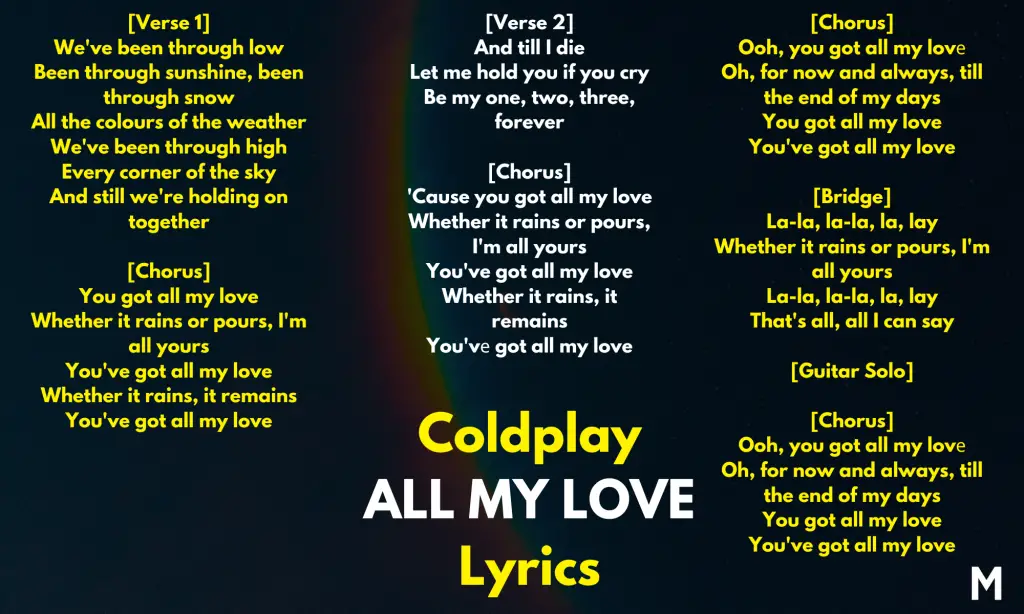Table of Contents
Images Courtesy of Parlophone Records Limited
Coldplay’s new track “All My Love” might seem like a straightforward love song at first, but there’s more going on beneath the surface. The lyrics use natural imagery and emotional language to dig into deeper themes of commitment and endurance.
With my background in English lit and creative writing from the University of Oregon (go ducks English dept), I’m going to take a poetic approach to this analysis and connect the song’s metaphors of sunshine, snow, and rain to themes found in the works of Robert Frost, Elizabeth Barrett Browning, and Sylvia Plath.
See Coldplay Live On Tour Here👈
Snag Coldplay On Vinyl Here👈
Now, I want to be clear—these are just my interpretations, not the definitive meaning of the song. But by pulling in some literary references, we can see how “All My Love” taps into a broader tradition of exploring love’s ability to endure through life’s inevitable highs and lows. The lyrics might not be aiming for subtlety, but that’s what makes them perfect for this kind of analysis.
So let’s break it down and see how Coldplay’s take on love stands up when viewed through a poetic lens.
Coldplay All My Love Lyrics

Coldplay’s “All My Love” Meaning and Analysis

Verse 1: Nature and Emotional Variability
The first verse of “All My Love” immediately sets the tone for a relationship that has been through all kinds of emotional weather. The lyrics “We’ve been through low / Been through sunshine, been through snow / All the colours of the weather” use a mix of natural imagery to describe the highs and lows experienced by the couple. The phrase “all the colours of the weather” points to a broad range of experiences, much like how poets such as William Wordsworth use vivid natural descriptions to convey varied emotional landscapes.
In “I Wandered Lonely as a Cloud,” Wordsworth describes the landscape to mirror his inner emotional state. Similarly, Coldplay’s speaker suggests that they’ve seen it all—joy, hardship, and everything in between—indicating that love is multifaceted and can survive under any conditions.
The contrast between “sunshine” and “snow” is about the internal states of joy and coldness that the relationship has encountered.
This is similar to how Sylvia Plath often juxtaposed contrasting elements to express the peaks and valleys of her own emotional experiences. For example, in “Tulips,” she sets the bright red tulips against a sterile, white hospital room to explore her sense of being overwhelmed. Just like Plath’s tulips, the weather in Coldplay’s lyrics isn’t just descriptive—it’s symbolic of the unpredictability and beauty of human emotion.
Chorus: Repetition and Unconditional Love
When the song reaches its chorus—“You got all my love / Whether it rains or pours, I’m all yours”—it doubles down on the theme of steadfast love. The repetition of “all my love” drives home the idea that the speaker’s commitment is complete and unwavering. It’s a technique that calls to mind Elizabeth Barrett Browning’s use of repetition in “Sonnet 43”, where she reinforces her love’s strength and purity through repeated affirmations like “I love thee to the depth and breadth and height / My soul can reach.” In both the poem and the song, the message is clear: love endures regardless of external circumstances.
The metaphor of “rain” and “pour” is an effective way to illustrate adversity, but in this context, the speaker is saying that love remains unchanged through both a light drizzle and a torrential downpour. The speaker’s declaration of being “all yours” no matter what reflects the type of emotional resilience Barrett Browning conveys in her sonnet. Even if the relationship faces difficult “weather,” the speaker promises to remain by their partner’s side.
Verse 2: Commitment and Eternal Love
The second verse introduces a sense of permanence and loyalty with the line: “And till I die / Let me hold you if you cry / Be my one, two, three, forever.” Here, the speaker’s vow to stand by their partner’s side “till I die” echoes the sentiment of Shakespeare’s Sonnet 18, where he proclaims that true love is eternal and unaffected by time’s passage: “But thy eternal summer shall not fade.”
Just as Shakespeare’s sonnet immortalizes the beloved’s beauty and constancy, Coldplay’s lyrics suggest that love, when true, has no expiration date.
When the speaker expresses a desire to “hold you if you cry,” it positions them as a source of comfort and strength. This mirrors John Donne’s depiction of love in “A Valediction: Forbidding Mourning.” Donne writes that love is not diminished by physical separation but instead grows stronger as it expands. In the same way, Coldplay’s speaker offers unconditional support and companionship, emphasizing that love is more than just being present—it’s about emotional solidarity.
Bridge: Simplicity and Clarity
The bridge’s simplicity—“La-la, la-la, la, lay”—serves as a moment of pause, giving listeners space to reflect on the sincerity of the speaker’s feelings. The repetitive, almost lullaby-like phrasing is reminiscent of Langston Hughes’s use of lyrical repetition in “The Negro Speaks of Rivers.” Hughes repeats the phrase “I’ve known rivers” to create a meditative rhythm, allowing the depth of his meaning to resonate.
Similarly, the bridge in “All My Love” helps to reinforce the central message of the song: love, in its truest form, is enduring and comforting even in its simplest expression.
Final Chorus: Absolute Devotion
In the final chorus, the lyrics—“Ooh, you got all my love / Oh, for now and always, till the end of my days”—bring the song’s themes full circle. The addition of “till the end of my days” emphasizes the idea of lifelong devotion, reinforcing the promise of unwavering support and affection. This closing statement captures what the entire song has been building towards: love, despite all its ups and downs, is a constant that persists through time and adversity.This declaration of eternal love—“till the end of my days”—again mirrors Shakespeare’s Sonnet 18 and echoes the tradition of love poetry that seeks to immortalize the beloved or the feeling of love itself.
The phrase “for now and always” also suggests a continuity that recalls Robert Frost’s “The Road Not Taken,” where decisions and emotions have lasting impacts. Just as Frost’s traveler must live with his chosen path, the speaker here has chosen to give “all my love,” a decision they affirm with absolute certainty.
Themes, Meanings, and Main Takeaways
The main theme of this song is resilience and unconditional love, captured through the recurring metaphor of weather. Right from the start, you see the speaker affirming their commitment with lines like, “Whether it rains or pours, I’m all yours.” That use of weather—where sunshine symbolizes good times and rain represents adversity—reminds me of Robert Frost’s Stopping by Woods on a Snowy Evening.
In Frost’s poem, the snow-covered woods symbolize a state of reflection and perseverance through tough conditions. Similarly, the way the song’s speaker uses “sunshine” and “snow” to describe emotional states taps into that same idea: just like Frost’s speaker chooses to keep moving through the woods, the song’s speaker promises to stay grounded no matter what storms the relationship faces.
The song’s insistence on giving “all my love” no matter what happens also has a strong connection to Elizabeth Barrett Browning’s Sonnet 43. Browning expresses love in varying intensities—“I love thee to the depth and breadth and height / My soul can reach”—which echoes in the song’s repetition of “You’ve got all my love.” Both pieces use similar phrasing to drive home the idea of constant, unwavering affection.
The song’s promise to keep giving “all my love” through “rain or shine” emphasizes absolute devotion, even when things get tough. It’s positioning love as something that can’t be shaken by external circumstances, just like Browning’s poem defines love by its strength and boundless capacity.
Finally, the use of weather as a metaphor for emotions ties directly into Sylvia Plath’s Tulips, where she contrasts bright red tulips with a sterile, white hospital room to show how overwhelming emotions can feel. In the same way, the song uses different weather elements—rain, snow, sunshine—to show the ups and downs of a relationship.
When the speaker talks about going through “all the colors of the weather,” they’re hinting at a relationship that’s faced every kind of emotional climate—highs, lows, and everything in between. It’s that willingness to embrace all these changes that really speaks to the strength of their bond, showing that true love is about sticking around through every season, not just the sunny days.
Will Vance is a professional music producer who has been involved in the industry for the better part of a decade and has been the managing editor at Magnetic Magazine since mid-2022. In that time period, he has published thousands of articles on music production, industry think pieces and educational articles about the music industry. Over the last decade as a professional music producer, Will Vance has also ran multiple successful and highly respected record labels in the industry, including Where The Heart Is Records as well as having launched a new label with a focus on community through Magnetic Magazine. When not running these labels or producing his own music, Vance is likely writing for other top industry sites like Waves or the Hyperbits Masterclass or working on his upcoming book on mindfulness in music production. On the rare chance he's not thinking about music production, he's probably running a game of Dungeons and Dragons with his friends which he has been the dungeon master for for many years.









